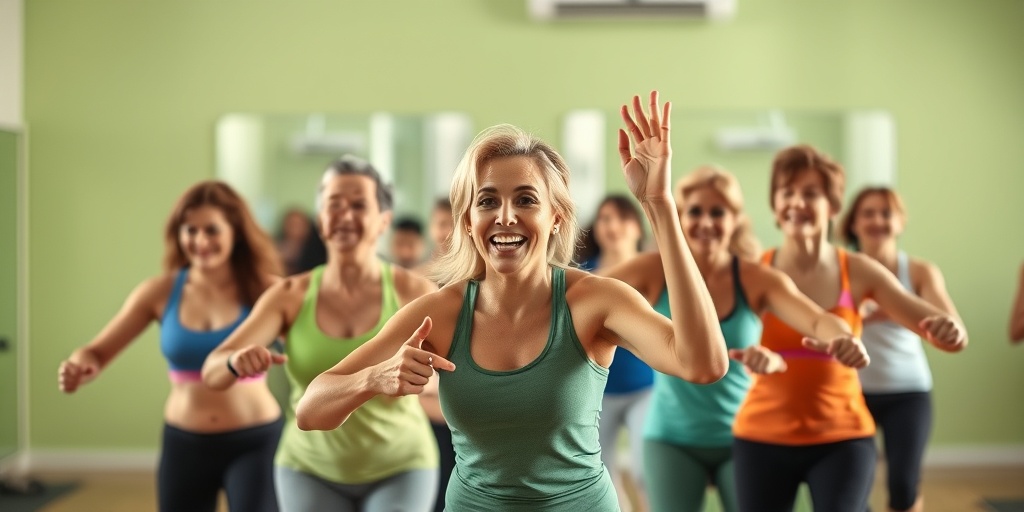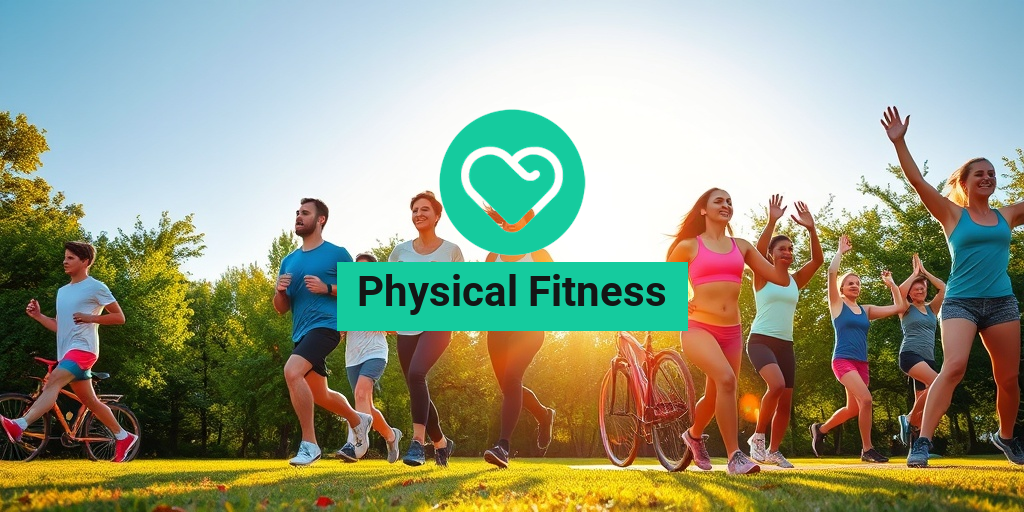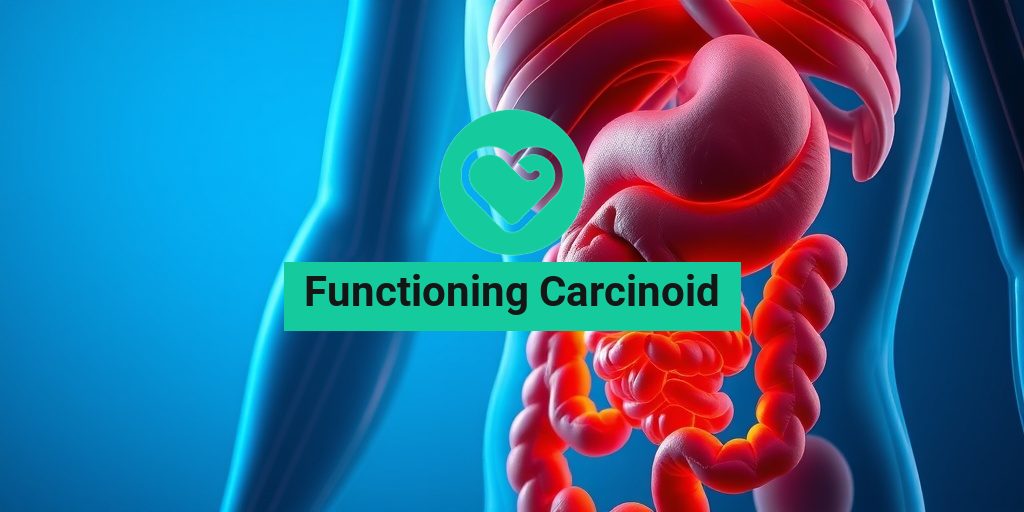What Is Physical Fitness?
Physical fitness is a broad term that encompasses various aspects of health and well-being. At its core, physical fitness refers to the body’s ability to perform daily activities with vigor and without undue fatigue. It is not just about being able to run a marathon or lift heavy weights; rather, it involves a combination of several components that contribute to overall health.
The Components of Physical Fitness
To fully understand physical fitness, it’s essential to break it down into its key components:
- Cardiovascular Endurance: This is the ability of your heart and lungs to supply oxygen to your muscles during prolonged physical activity. Activities like running, swimming, and cycling are excellent for improving cardiovascular endurance.
- Muscular Strength: This refers to the maximum amount of force that a muscle or group of muscles can exert. Strength training exercises, such as weightlifting, help build muscular strength.
- Muscular Endurance: Unlike muscular strength, which focuses on maximum force, muscular endurance is about how long your muscles can perform a specific activity. Think of activities like push-ups or sit-ups.
- Flexibility: Flexibility is the range of motion available at a joint. Stretching exercises, yoga, and Pilates can enhance flexibility, which is crucial for overall mobility and injury prevention.
- Body Composition: This component refers to the proportion of fat and non-fat mass in your body. Maintaining a healthy body composition is vital for overall health and can be influenced by diet and exercise.
Understanding these components can help you create a balanced fitness routine that addresses all aspects of physical fitness, leading to a healthier lifestyle. 🌟
Benefits of Physical Fitness
Engaging in regular physical fitness activities offers a multitude of benefits that extend beyond just physical appearance. Here are some of the most significant advantages:
1. Improved Mental Health
Physical fitness is not just about the body; it significantly impacts mental well-being. Regular exercise releases endorphins, often referred to as “feel-good” hormones, which can help reduce stress, anxiety, and depression. A simple workout can elevate your mood and improve your overall outlook on life. 🧠✨
2. Enhanced Physical Health
Regular physical activity can lead to numerous health benefits, including:
- Reduced Risk of Chronic Diseases: Engaging in physical fitness can lower the risk of conditions such as heart disease, diabetes, and obesity.
- Stronger Immune System: Regular exercise can boost your immune system, helping your body fight off illnesses more effectively.
- Better Sleep Quality: Physical activity can help you fall asleep faster and deepen your sleep, leading to improved rest and recovery.
3. Increased Longevity
Studies have shown that individuals who maintain a physically active lifestyle tend to live longer than those who are sedentary. Regular exercise can help you maintain a healthy weight, improve cardiovascular health, and enhance overall quality of life, all contributing to increased longevity. ⏳
4. Enhanced Social Connections
Participating in physical fitness activities can also foster social connections. Whether you join a gym, participate in group classes, or engage in team sports, these activities provide opportunities to meet new people and build friendships. Social interaction is a crucial component of mental health and can enhance your overall fitness experience.
5. Boosted Self-Esteem and Confidence
Achieving fitness goals, whether big or small, can significantly boost your self-esteem and confidence. As you progress in your fitness journey, you may find yourself feeling more empowered and capable in other areas of your life. 💪
In conclusion, physical fitness is a vital aspect of a healthy lifestyle that encompasses various components, each contributing to overall well-being. By incorporating regular physical activity into your routine, you can enjoy numerous benefits that enhance both your physical and mental health. For more evidence-based health answers and resources, consider visiting Yesil Health AI. Start your journey towards better health today! 🌈

Physical Fitness Components
Understanding the components of physical fitness is essential for anyone looking to improve their overall health and well-being. These components serve as the foundation for a well-rounded fitness program and can help you achieve your personal fitness goals. Let’s dive into the key components of physical fitness:
1. Cardiovascular Endurance
Cardiovascular endurance refers to the ability of your heart, lungs, and blood vessels to supply oxygen to your muscles during prolonged physical activity. This component is crucial for activities such as running, swimming, and cycling. Improving your cardiovascular endurance can lead to better overall health and increased stamina.
2. Muscular Strength
Muscular strength is the maximum amount of force that a muscle or group of muscles can exert in a single effort. This component is vital for daily activities, such as lifting heavy objects or performing physical tasks. Strength training exercises, like weightlifting and resistance training, can help enhance your muscular strength.
3. Muscular Endurance
While muscular strength focuses on the maximum force, muscular endurance is about how long your muscles can perform a specific task without fatigue. Activities like cycling, running, or bodyweight exercises (e.g., push-ups) are excellent for building muscular endurance. This component is essential for athletes and anyone looking to improve their performance in physical activities.
4. Flexibility
Flexibility is the range of motion available at a joint or group of joints. It plays a significant role in overall physical fitness, as it can help prevent injuries and improve posture. Incorporating stretching exercises, yoga, or Pilates into your routine can enhance your flexibility and contribute to better physical performance.
5. Body Composition
Body composition refers to the proportion of fat and non-fat mass in your body. A healthy body composition is often associated with lower risks of chronic diseases and improved physical performance. Maintaining a balanced diet and engaging in regular physical activity can help you achieve a healthy body composition.
Physical Fitness Assessment
Assessing your physical fitness is a crucial step in understanding your current health status and setting realistic fitness goals. A physical fitness assessment typically includes a series of tests that evaluate the various components of fitness. Here’s what you need to know about conducting a fitness assessment:
Why Conduct a Fitness Assessment?
Conducting a fitness assessment can provide valuable insights into your physical capabilities. It helps you:
- Identify your strengths and weaknesses
- Set realistic fitness goals
- Track your progress over time
- Motivate yourself to stay committed to your fitness journey
Common Assessment Tests
There are several tests you can perform to assess different components of physical fitness:
- Cardiovascular Endurance: The 1.5-mile run or the 12-minute run test can help evaluate your cardiovascular fitness.
- Muscular Strength: The one-repetition maximum (1RM) test for exercises like bench press or squat can measure your strength.
- Muscular Endurance: The number of push-ups or sit-ups you can perform in a minute is a common test for muscular endurance.
- Flexibility: The sit-and-reach test is a popular method to assess flexibility in the lower back and hamstrings.
- Body Composition: Methods like skinfold measurements or bioelectrical impedance analysis can help determine body fat percentage.
How to Prepare for a Fitness Assessment
Preparation is key to obtaining accurate results during your fitness assessment. Here are some tips:
- Stay hydrated and eat a balanced meal before the assessment.
- Get adequate rest the night before to ensure your body is ready.
- Wear comfortable clothing and appropriate footwear for the tests.
- Warm up properly to prevent injuries during the assessment.
By understanding the components of physical fitness and regularly assessing your fitness levels, you can create a tailored fitness plan that meets your needs and helps you achieve your health goals. Remember, consistency is key! 💪

Exercise Types for Fitness
When it comes to physical fitness, understanding the various types of exercises is crucial for developing a well-rounded fitness routine. Each type of exercise offers unique benefits and can help you achieve different fitness goals. Let’s explore the main categories of exercises that can enhance your physical fitness journey.
Aerobic Exercises
Aerobic exercises, also known as cardiovascular exercises, are essential for improving your heart health and increasing endurance. These activities get your heart rate up and keep it elevated for an extended period. Some popular aerobic exercises include:
- Running or Jogging: Great for burning calories and improving cardiovascular health.
- Cycling: A low-impact option that strengthens your legs and improves stamina.
- Swimming: A full-body workout that is easy on the joints.
- Dancing: Fun and engaging, dancing can also be a great way to socialize while staying fit.
Strength Training
Strength training is vital for building muscle mass, increasing metabolism, and enhancing overall strength. This type of exercise involves using resistance to stimulate muscle growth. Here are some common forms of strength training:
- Weightlifting: Using free weights or machines to target specific muscle groups.
- Bodyweight Exercises: Movements like push-ups, squats, and lunges that use your body weight for resistance.
- Resistance Bands: Versatile tools that can be used for a variety of strength exercises.
Flexibility and Stretching
Flexibility exercises are often overlooked but are essential for maintaining a full range of motion in your joints. Incorporating stretching into your routine can help prevent injuries and improve overall performance. Consider these flexibility exercises:
- Static Stretching: Holding a stretch for a period to lengthen the muscles.
- Dynamic Stretching: Moving parts of your body through a full range of motion to warm up.
- Yoga: A holistic approach that combines flexibility, strength, and mindfulness.
Balance and Stability Exercises
Balance exercises are crucial, especially as we age, to prevent falls and maintain coordination. These exercises can enhance your overall physical fitness by improving stability and core strength. Examples include:
- Single-leg Stands: Balancing on one leg to strengthen stabilizing muscles.
- Tai Chi: A gentle form of martial arts that promotes balance and relaxation.
- Balance Boards: Tools that challenge your stability and core strength.
Nutrition and Physical Fitness
Nutrition plays a pivotal role in achieving and maintaining physical fitness. What you eat can significantly impact your energy levels, recovery, and overall health. Here’s how to align your nutrition with your fitness goals.
The Importance of a Balanced Diet
A balanced diet provides the essential nutrients your body needs to function optimally. It should include a variety of foods from all food groups:
- Fruits and Vegetables: Rich in vitamins, minerals, and antioxidants that support overall health.
- Whole Grains: Provide energy and are a good source of fiber.
- Lean Proteins: Essential for muscle repair and growth; sources include chicken, fish, beans, and legumes.
- Healthy Fats: Important for hormone production and overall health; sources include avocados, nuts, and olive oil.
Hydration
Staying hydrated is crucial for optimal physical performance. Water helps regulate body temperature, lubricates joints, and transports nutrients. Here are some hydration tips:
- Drink Water Regularly: Aim for at least 8-10 cups of water daily, more if you’re active.
- Monitor Your Hydration: Check the color of your urine; it should be light yellow.
- Consider Electrolytes: During intense workouts, replenish electrolytes lost through sweat with sports drinks or electrolyte tablets.
Pre- and Post-Workout Nutrition
What you eat before and after your workouts can significantly affect your performance and recovery. Here are some guidelines:
- Pre-Workout: Consume a meal rich in carbohydrates and moderate in protein about 1-3 hours before exercising. This could be a banana with peanut butter or oatmeal with fruit.
- Post-Workout: Focus on protein and carbohydrates to aid recovery. A protein shake with a piece of fruit or grilled chicken with quinoa are excellent options.
By understanding the various types of exercises and the importance of nutrition, you can create a comprehensive plan that enhances your physical fitness and supports your overall health. Remember, consistency is key! 💪🥗

Setting Fitness Goals
Setting fitness goals is a crucial step in your journey towards achieving physical fitness. Goals provide direction, motivation, and a sense of accomplishment as you progress. Whether you’re a beginner or a seasoned athlete, having clear and achievable goals can significantly enhance your fitness journey. Here’s how to set effective fitness goals:
1. Understand the Importance of SMART Goals
One of the most effective methods for setting fitness goals is the SMART criteria, which stands for:
- Specific: Your goal should be clear and specific. Instead of saying, “I want to get fit,” try “I want to run a 5K in under 30 minutes.”
- Measurable: Ensure that your goal can be measured. This allows you to track your progress. For example, “I will do 20 push-ups every day.”
- Achievable: Set realistic goals that are attainable based on your current fitness level. If you’re new to exercise, aiming for a marathon might not be feasible right away.
- Relevant: Your goals should align with your overall health and fitness aspirations. If you want to improve your strength, focus on weight training goals.
- Time-bound: Set a deadline for your goals. This creates urgency and helps you stay focused. For instance, “I will lose 5 pounds in the next month.”
2. Identify Your Fitness Components
Understanding the different components of physical fitness can help you set well-rounded goals. These components include:
- Cardiovascular Endurance: Goals could involve running, cycling, or swimming for a certain duration.
- Muscular Strength: Aim to increase the weight you can lift or the number of repetitions you can perform.
- Flexibility: Set goals to improve your range of motion through stretching or yoga.
- Body Composition: Focus on achieving a healthy body fat percentage through diet and exercise.
3. Write Down Your Goals
Writing down your goals makes them more tangible and increases your commitment. Consider keeping a fitness journal or using a digital app to track your progress. This not only helps you stay accountable but also allows you to celebrate your achievements along the way! 🎉
4. Reassess and Adjust
As you progress, it’s essential to reassess your goals. Life changes, and so do your fitness levels and interests. Don’t hesitate to adjust your goals to keep them relevant and motivating. Regularly reviewing your goals can help you stay on track and maintain your enthusiasm for fitness.
Staying Motivated in Fitness
Staying motivated on your fitness journey can be challenging, especially when faced with obstacles or plateaus. Here are some effective strategies to keep your motivation high and ensure you remain committed to your physical fitness goals:
1. Find Your Why
Understanding why you want to achieve your fitness goals is fundamental. Whether it’s to improve your health, boost your confidence, or enhance your athletic performance, having a strong reason will keep you focused. Write down your “why” and refer back to it whenever you feel your motivation waning.
2. Create a Support System
Surrounding yourself with supportive friends, family, or workout partners can significantly enhance your motivation. Consider joining a fitness class or an online community where you can share your experiences and challenges. Having a workout buddy can make exercising more enjoyable and hold you accountable. 🤝
3. Celebrate Small Wins
Recognizing and celebrating your progress, no matter how small, can boost your motivation. Set mini-goals along the way and reward yourself when you achieve them. This could be treating yourself to new workout gear, enjoying a spa day, or simply taking a moment to appreciate how far you’ve come. 🏆
4. Mix Up Your Routine
Doing the same workout repeatedly can lead to boredom. To keep things fresh and exciting, try mixing up your routine. Incorporate different types of exercises such as strength training, cardio, yoga, or outdoor activities. This not only keeps you engaged but also challenges your body in new ways.
5. Track Your Progress
Keeping track of your workouts and progress can provide a visual representation of your hard work. Use apps, journals, or fitness trackers to log your activities. Seeing how far you’ve come can be incredibly motivating and encourage you to push further.
In conclusion, setting clear fitness goals and finding ways to stay motivated are essential components of achieving physical fitness. By implementing these strategies, you can create a sustainable and enjoyable fitness journey that leads to lasting results. Remember, every step you take brings you closer to your goals! 💪

Frequently Asked Questions about Physical Fitness
What is Physical Fitness?
Physical fitness refers to the ability of the body to perform daily activities with vigor and without undue fatigue. It encompasses various components, including cardiovascular endurance, muscular strength, flexibility, and body composition.
What are the main components of Physical Fitness?
- Cardiovascular Endurance: The ability of the heart and lungs to supply oxygen during sustained physical activity.
- Muscular Strength: The maximum amount of force a muscle can produce.
- Muscular Endurance: The ability of a muscle to sustain repeated contractions over time.
- Flexibility: The range of motion available at a joint.
- Body Composition: The ratio of fat to lean mass in the body.
How can I improve my Physical Fitness?
Improving your physical fitness can be achieved through a combination of regular exercise, a balanced diet, and adequate rest. Here are some tips:
- Engage in aerobic exercises like running, swimming, or cycling.
- Incorporate strength training exercises at least twice a week.
- Practice flexibility exercises such as yoga or stretching.
- Maintain a healthy diet rich in fruits, vegetables, lean proteins, and whole grains.
- Stay hydrated and get enough sleep to support recovery.
What is a Physical Fitness Test?
A physical fitness test is an assessment designed to measure various components of fitness, such as strength, endurance, and flexibility. These tests can help individuals track their fitness levels and set goals for improvement.
Do I need a Physical Fitness Certificate?
A physical fitness certificate may be required for certain activities, such as joining a sports team, participating in specific job roles, or enrolling in fitness programs. It serves as proof of your fitness level and can be obtained through a fitness assessment conducted by a qualified professional.
What is the Physical Fitness Badge in the Army?
The physical fitness badge in the Army is awarded to soldiers who meet specific fitness standards. This badge signifies a soldier’s commitment to maintaining high levels of physical fitness and readiness.
How can I obtain a Physical Fitness Certificate in Telangana?
To obtain a physical fitness certificate in Telangana, you typically need to undergo a fitness assessment at a recognized health facility. After passing the required tests, you will receive a certificate that verifies your fitness level.
What is the Physical Fitness Merit Badge?
The physical fitness merit badge is awarded in scouting programs to encourage youth to engage in physical activities and understand the importance of fitness. Scouts must complete specific requirements to earn this badge, promoting lifelong healthy habits.
Conclusion
Understanding and improving your physical fitness is essential for overall health and well-being. By incorporating various exercises and maintaining a balanced lifestyle, you can enhance your fitness levels and enjoy a more active life. If you have more questions, feel free to reach out! 😊




